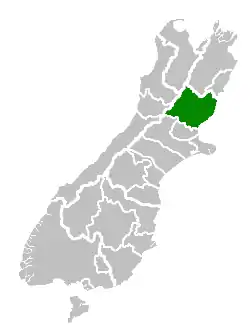Hurunui District
Hurunui District is a territorial local government district within the Canterbury Region on the east coast of New Zealand's South Island, north of Christchurch. It stretches from the east coast to the Main Divide. Its land area is 8,640.96 square kilometres (3,336.29 sq mi).
Hurunui District | |
|---|---|
 Hurunui District Offices in Amberley | |
 Location of the Hurunui District within the South Island | |
| Country | New Zealand |
| Region | Canterbury |
| District | Hurunui District Council |
| Wards | Amberley Amuri-Hurunui Hanmer Springs Cheviot Glenmark |
| Formed | 1989 |
| Seat | Amberley |
| Government | |
| • Mayor | Marie Black |
| • Deputy Mayor | Vince Daly |
| Area | |
| • Total | 8,640.96 km2 (3,336.29 sq mi) |
| Population (June 2020)[1] | |
| • Total | 13,300 |
| • Density | 1.5/km2 (4.0/sq mi) |
| Time zone | UTC+12 (NZST) |
| • Summer (DST) | UTC+13 (NZDT) |
| Postcode(s) | |
| Website | Hurunui District Council |
Population
The district had a usually resident population of 13,300 as of June 2020.[1]
| Year | Pop. | ±% p.a. |
|---|---|---|
| 2006 | 10,476 | — |
| 2013 | 11,529 | +1.38% |
| 2018 | 12,558 | +1.72% |
| Source: [2] | ||
Hurunui District had a population of 12,558 at the 2018 New Zealand census, an increase of 1,029 people (8.9%) since the 2013 census, and an increase of 2,082 people (19.9%) since the 2006 census. There were 4,926 households. There were 6,369 males and 6,192 females, giving a sex ratio of 1.03 males per female. The median age was 44.4 years; 2,427 people (19.3%) were aged up to 15 years, 1,812 (14.4%) were 15 to 29, 5,841 (46.5%) were 30 to 64, and 2,478 (19.7%) were 65 or older.
Ethnicities were 92.0% European/Pākehā, 8.6% Māori, 1.1% Pacific peoples, 3.9% Asian, and 2.1% other ethnicities (totals add to more than 100% since people may identify with multiple ethnicities).[2] It also shares with the Waitaki District the distinction of having the lowest non-European population anywhere in New Zealand in both raw numbers and proportion.[3]
The proportion of people born overseas was 16.6%, compared with 27.1% nationally.
Although some people objected to giving their religion, 52.5% had no religion, 36.6% were Christian, and 2.9% had other religions.
Of those at least 15 years old, 1,590 (15.7%) people had a bachelor or higher degree, and 2,064 (20.4%) people had no formal qualifications. The median income was $31,600. The employment status of those at least 15 was that 5,277 (52.1%) people were employed full-time, 1,788 (17.6%) were part-time, and 195 (1.9%) were unemployed.[2]
Urban areas and settlements
Amberley, the district seat, is the only town in the Hurunui district with a population over 1,000. It is home to 2,270 people, 17.1% of the district's population.[1]
Other settlements and localities in the district include the following:
|
|
|
Local government
During the period, 1853 to 1876, the area north of the Hurunui River was administered as part of the Nelson Province. After the abolition of the provinces in 1876 the Amuri and Cheviot counties were formed. In the 1989 local government reforms, these counties were merged with Hurunui County to form the present district.[4] The current district mayor is Marie Black, who was elected in 2019 upon the retirement of previous mayor Winton Dalley.[5]
References
- "Population estimate tables - NZ.Stat". Statistics New Zealand. Retrieved 22 October 2020.
- "Statistical area 1 dataset for 2018 Census". Statistics New Zealand. March 2020. Hurunui District (058). 2018 Census place summary: Hurunui District
- "Our whitest region". The New Zealand Herald. 5 August 2007. Retrieved 28 April 2020.
- "Council archives". Hurunui District Council. Retrieved 29 April 2020.
- "2019 Local Body Elections". Hurunui District Council. Retrieved 11 April 2020.
External links
![]() Media related to Hurunui District at Wikimedia Commons
Media related to Hurunui District at Wikimedia Commons